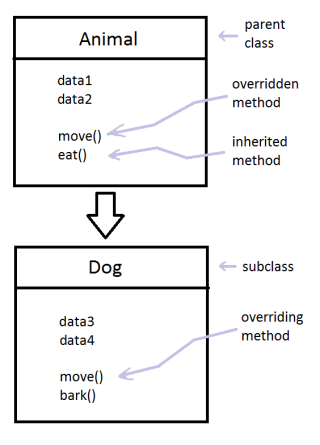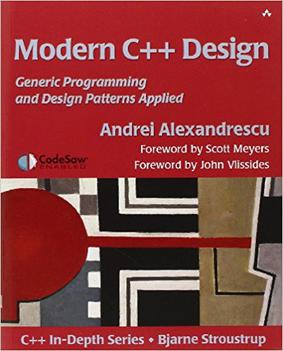Related Research Articles
Templates are a feature of the C++ programming language that allows functions and classes to operate with generic types. This allows a function or class declaration to reference via a generic variable another different class without creating full declaration for each of these different classes.
The bridge pattern is a design pattern used in software engineering that is meant to "decouple an abstraction from its implementation so that the two can vary independently", introduced by the Gang of Four. The bridge uses encapsulation, aggregation, and can use inheritance to separate responsibilities into different classes.
In computer programming, lazy initialization is the tactic of delaying the creation of an object, the calculation of a value, or some other expensive process until the first time it is needed. It is a kind of lazy evaluation that refers specifically to the instantiation of objects or other resources.
In object-oriented programming, the decorator pattern is a design pattern that allows behavior to be added to an individual object, dynamically, without affecting the behavior of other instances of the same class. The decorator pattern is often useful for adhering to the Single Responsibility Principle, as it allows functionality to be divided between classes with unique areas of concern as well as to the Open-Closed Principle, by allowing the functionality of a class to be extended without being modified. Decorator use can be more efficient than subclassing, because an object's behavior can be augmented without defining an entirely new object.
Template metaprogramming (TMP) is a metaprogramming technique in which templates are used by a compiler to generate temporary source code, which is merged by the compiler with the rest of the source code and then compiled. The output of these templates can include compile-time constants, data structures, and complete functions. The use of templates can be thought of as compile-time polymorphism. The technique is used by a number of languages, the best-known being C++, but also Curl, D, Nim, and XL.
A method in object-oriented programming (OOP) is a procedure associated with an object, and generally also a message. An object consists of state data and behavior; these compose an interface, which specifies how the object may be used. A method is a behavior of an object parametrized by a user.
In mathematics and computer science, a higher-order function (HOF) is a function that does at least one of the following:
In programming language theory and type theory, polymorphism is the use of a single symbol to represent multiple different types.
In object-oriented programming such as is often used in C++ and Object Pascal, a virtual function or virtual method is an inheritable and overridable function or method that is dispatched dynamically. Virtual functions are an important part of (runtime) polymorphism in object-oriented programming (OOP). They allow for the execution of target functions that were not precisely identified at compile time.
In computer science, a tagged union, also called a variant, variant record, choice type, discriminated union, disjoint union, sum type, or coproduct, is a data structure used to hold a value that could take on several different, but fixed, types. Only one of the types can be in use at any one time, and a tag field explicitly indicates which type is in use. It can be thought of as a type that has several "cases", each of which should be handled correctly when that type is manipulated. This is critical in defining recursive datatypes, in which some component of a value may have the same type as that value, for example in defining a type for representing trees, where it is necessary to distinguish multi-node subtrees and leaves. Like ordinary unions, tagged unions can save storage by overlapping storage areas for each type, since only one is in use at a time.
In computer programming, a function object is a construct allowing an object to be invoked or called as if it were an ordinary function, usually with the same syntax. In some languages, particularly C++, function objects are often called functors.

Method overriding, in object-oriented programming, is a language feature that allows a subclass or child class to provide a specific implementation of a method that is already provided by one of its superclasses or parent classes. In addition to providing data-driven algorithm-determined parameters across virtual network interfaces, it also allows for a specific type of polymorphism (subtyping). The implementation in the subclass overrides (replaces) the implementation in the superclass by providing a method that has same name, same parameters or signature, and same return type as the method in the parent class. The version of a method that is executed will be determined by the object that is used to invoke it. If an object of a parent class is used to invoke the method, then the version in the parent class will be executed, but if an object of the subclass is used to invoke the method, then the version in the child class will be executed. This helps in preventing problems associated with differential relay analytics which would otherwise rely on a framework in which method overriding might be obviated. Some languages allow a programmer to prevent a method from being overridden.

Modern C++ Design: Generic Programming and Design Patterns Applied is a book written by Andrei Alexandrescu, published in 2001 by Addison-Wesley. It has been regarded as "one of the most important C++ books" by Scott Meyers.
typedef is a reserved keyword in the programming languages C, C++, and Objective-C. It is used to create an additional name (alias) for another data type, but does not create a new type, except in the obscure case of a qualified typedef of an array type where the typedef qualifiers are transferred to the array element type. As such, it is often used to simplify the syntax of declaring complex data structures consisting of struct and union types, although it is also commonly used to provide specific descriptive type names for integer data types of varying sizes.
A class in C++ is a user-defined type or data structure declared with any of the keywords class, struct or union that has data and functions as its members whose access is governed by the three access specifiers private, protected or public. By default access to members of a C++ class declared with the keyword class is private. The private members are not accessible outside the class; they can be accessed only through member functions of the class. The public members form an interface to the class and are accessible outside the class.
C++11 is a version of the ISO/IEC 14882 standard for the C++ programming language. C++11 replaced the prior version of the C++ standard, called C++03, and was later replaced by C++14. The name follows the tradition of naming language versions by the publication year of the specification, though it was formerly named C++0x because it was expected to be published before 2010.
Substitution failure is not an error (SFINAE) is a principle in C++ where an invalid substitution of template parameters is not in itself an error. David Vandevoorde first introduced the acronym SFINAE to describe related programming techniques.
Expression templates are a C++ template metaprogramming technique that builds structures representing a computation at compile time, where expressions are evaluated only as needed to produce efficient code for the entire computation. Expression templates thus allow programmers to bypass the normal order of evaluation of the C++ language and achieve optimizations such as loop fusion.
In computer programming, variadic templates are templates that take a variable number of arguments.
"typename" is a keyword in the C++ programming language used when writing templates. It is used for specifying that a dependent name in a template definition or declaration is a type. In the original C++ compilers before the first ISO standard was completed, the typename keyword was not part of the C++ language and Bjarne Stroustrup used the class keyword for template arguments instead. While typename is now the preferred keyword, older source code may still use the class keyword instead.
References
- ↑ Abrahams, David; Gurtovoy, Aleksey (January 2005). C++ Template Metaprogramming: Concepts, Tools, and Techniques from Boost and Beyond. Addison-Wesley. ISBN 0-321-22725-5.
- ↑ William Cook; et al. (1989). "F-Bounded Polymorphism for Object-Oriented Programming" (PDF).
- ↑ Coplien, James O. (February 1995). "Curiously Recurring Template Patterns" (PDF). C++ Report: 24–27.
- ↑ Budd, Timothy (1994). Multiparadigm programming in Leda. Addison-Wesley. ISBN 0-201-82080-3.
- ↑ "Apostate Café: ATL and Upside-Down Inheritance". 15 March 2006. Archived from the original on 15 March 2006. Retrieved 9 October 2016.
{{cite web}}: CS1 maint: bot: original URL status unknown (link) - ↑ "ATL and Upside-Down Inheritance". 4 June 2003. Archived from the original on 4 June 2003. Retrieved 9 October 2016.
{{cite web}}: CS1 maint: bot: original URL status unknown (link) - ↑ Alexandrescu, Andrei (2001). Modern C++ Design: Generic Programming and Design Patterns Applied. Addison-Wesley. ISBN 0-201-70431-5.
- ↑ Coplien, James; Bjørnvig, Gertrud (2010). Lean Architecture: for agile software development. Wiley. ISBN 978-0-470-68420-7.
- ↑ "std::enable_shared_from_this" . Retrieved 22 November 2022.
- ↑ "Simulated Dynamic Binding". 7 May 2003. Archived from the original on 9 February 2012. Retrieved 13 January 2012.
- ↑ Meyers, Scott (April 1998). "Counting Objects in C++". C/C++ Users Journal.
- ↑ Arena, Marco (29 April 2012). "Use CRTP for polymorphic chaining" . Retrieved 15 March 2017.
- ↑ Gašper Ažman; Sy Brand; Ben Deane; Barry Revzin (12 July 2021). "Deducing this".
- ↑ "Explicit object parameter" . Retrieved 27 December 2023.